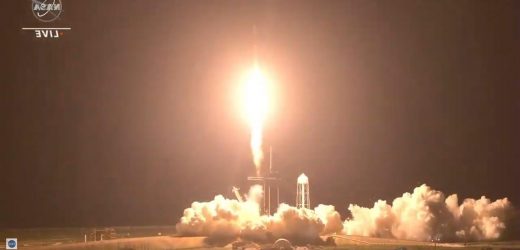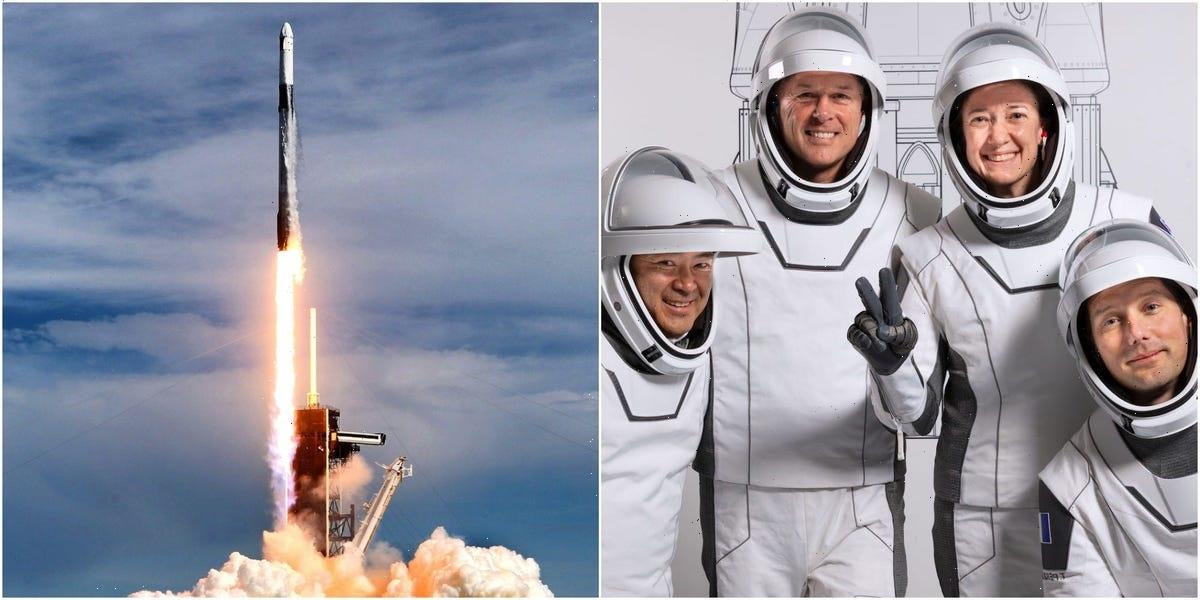- SpaceX launched four astronauts into orbit for NASA early Friday morning.
- The Crew-2 mission is using a recycled Crew Dragon spaceship and Falcon 9 rocket booster.
- Now the Crew Dragon, named Endeavour, must dock to a crowded International Space Station.
- See more stories on Insider’s business page.
A recycled SpaceX rocket launched a multinational crew of four astronauts into Earth’s orbit on Friday, kicking off a NASA mission called Crew-2.
The engines of the company’s Falcon 9 rocket roared to life precisely two seconds after 5:49 a.m. ET, cutting across the early-morning twilight and heaving the vehicle off NASA’s Kennedy Space Center launchpad in Florida.
The four astronauts — Shane Kimbrough and Megan McArthur of NASA, Akihiko Hoshide of the Japan Aerospace Exploration Agency, and Thomas Pesquet of the European Space Agency — were strapped into a Crew Dragon capsule at the tip of the rocket, pressed against their seats as it screamed through Earth’s atmosphere.
The mission is the first time SpaceX has reused a spaceship and rocket booster with crew on board. The company’s goal is to develop launch systems that are fully reusable — including the spaceship and both stages of the rocket. Doing so would allow for more efficient and lower-cost travel beyond Earth.
The Dragon spaceship separated from the rocket’s upper stage and slipped into orbit at 6:01 a.m. ET.
Now its mission is to deliver the astronauts to the International Space Station, to live and work for about six months. The spaceship is due to dock at the football-field-sized orbiting laboratory at 5:10 a.m. ET on Saturday. Until then, the crew will eat, rest, and prepare to join their fellow astronauts.
“We wish you a great mission, good luck, and enjoy the ride,” a SpaceX mission controller told the astronauts just before liftoff.
This is SpaceX’s second routine astronaut flight for NASA.
Crew Dragon became the first — and, so far, the only — commercial vehicle to carry humans into space last May, when NASA astronauts Doug Hurley and Bob Behnken took it on a three-month test flight to the ISS.
That mission, called Demo-2, was the first time a US spacecraft had launched people from US soil since the Space Shuttle program ended in 2011. Now Crew Dragon is the cornerstone of NASA’s renewed human spaceflight program.
SpaceX flew its first full-length four-astronaut mission, called Crew-1, in November. Those astronauts are still on the ISS, waiting to greet Crew-2. NASA has contracted four more SpaceX flights like this one, and it plans to use a different SpaceX vehicle, Starship, to land the next astronauts on the moon. Crew Dragon is also poised to carry the first civilian spaceflight in history, called Inspiration-4, in September.
Crew-2 is using a recycled rocket and spaceship
The spaceship that the Crew-2 astronauts are flying — a Crew Dragon capsule called Endeavour — is the same one that carried Hurley and Behnken.
McArthur, who is married to Behnken, is now piloting the Endeavour spaceship. The assignment was “a neat surprise, and kind of a fun twist on the whole thing,” she told reporters in March.
“I’m going to launch in the same seat. So that is kind of a fun thing that we can share, you know, I can tease him and say, ‘Hey, Can you hand over the keys? I’m ready now to go,'” she said.
The Falcon 9 booster, which is also reusable, is the same one that launched Crew-1 in November.
“Flying on reused vehicles, on flight-proven vehicles, is key towards greater flight reliability and lowering the cost of access to space, which is ultimately what helps us make life multiplanetary,” Benji Reed, senior director of human-spaceflight programs at SpaceX, said in a pre-flight press conference.
Reusability, he added, is “the holy grail of spaceflight.” SpaceX often compares traditional, non-reusable rocket development to building a plane, flying it once, and then throwing it away. Companies and government agencies could save a lot of money and time by reusing their launch vehicles.
SpaceX is expanding human spaceflight
These Crew Dragon missions are the fruit of NASA’s Commercial Crew Program, which began in 2010 to restore the agency’s human spaceflight capabilities. Through this program, NASA worked with SpaceX to make the Dragon spaceship and Falcon 9 capable of safely transporting humans. Their missions have restored US human spaceflight for the first time since the Space Shuttle program ended in 2011.
The world’s space agencies now have an alternative to the Russian Soyuz rockets they’ve been using to transport their astronauts for the last decade.
Boeing also participated in the Commercial Crew Program and developed a spaceship called Starliner. But it has to re-do an uncrewed test flight to the ISS before it can carry anybody into space.
The Starliner may not fly astronauts until next year.
As Ars Technica’s senior space editor, Eric Berger, recently reported, SpaceX vehicles will be taking up the ports on the ISS until late July, when Boeing has the earliest opportunity to fly an uncrewed Starliner.
Reviews, data analysis, and upgrades after that flight will likely take about six months before it can launch astronauts.
6 months on the space station, then a plunge back to Earth
When the Crew-2 astronauts arrive at the ISS, it will be crowded with 11 people. Some of them will need to sleep in makeshift beds for at least four days, until Crew-1 returns to Earth.
As early as April 28, those astronauts — Shannon Walker, Victor Glover, Mike Hopkins, and Soichi Noguchi — will climb back aboard their own Crew Dragon capsule.
That capsule, called Resilience, will then undock from the ISS, push itself toward Earth, and plummet through the atmosphere. The spaceship’s heat shield must protect the astronauts inside as its speed superheats the material around it up to 3,500 degrees Fahrenheit. Four parachutes should deploy to drift Resilience to a splashdown off the coast of Florida.
The Crew-2 astronauts will stay on the ISS for about six months, maintaining the station, doing repairs, and conducting scientific research.
Getting more astronauts to the ISS was one of the motivating goals behind the Commercial Crew Program. In addition to being cheaper than Soyuz flights, the Crew Dragon can fit one more astronaut than Soyuz. That means more capacity for space-station maintenance, technology development, and scientific experiments. The Crew-2 astronauts will be doing all those things during their time on the ISS.
The Crew-2 astronauts will return to Earth with their own splashdown in autumn.
Source: Read Full Article


